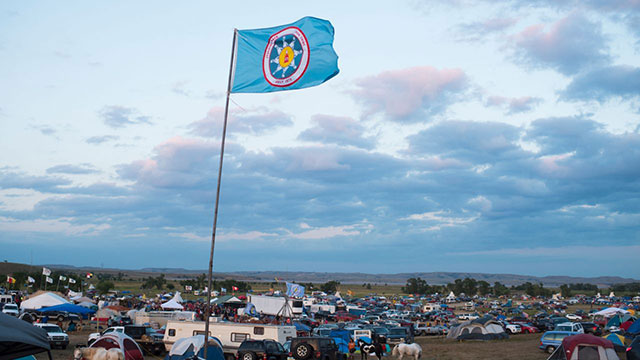
Part of the Series
Moyers and Company
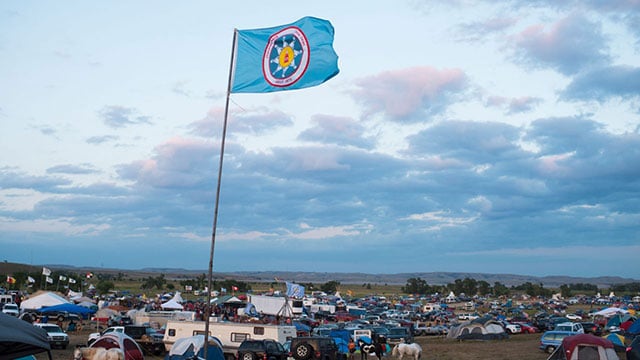 A Standing Rock Sioux flag flies over a protest encampment near Cannon Ball, North Dakota, where members of the Standing Rock nations and their supporters have gathered to voice their opposition to the Dakota Access pipeline. (Photo: Robyn Beck / AFP / Getty Images)
A Standing Rock Sioux flag flies over a protest encampment near Cannon Ball, North Dakota, where members of the Standing Rock nations and their supporters have gathered to voice their opposition to the Dakota Access pipeline. (Photo: Robyn Beck / AFP / Getty Images)
The first sign that not everything is normal as you drive down Highway 1806 toward the Standing Rock reservation in North Dakota is a checkpoint manned by camouflage-clad National Guard troops. The inspection on Sept. 13 was perfunctory; they simply asked if we knew “what was going on down the road” and then waved us through, even though the car we rode in had “#NoDAPL” chalked on its rear windshield.
“What is going on down the road” is a massive camp-in led by the Standing Rock nation, aimed at blocking the construction of the Dakota Access Pipeline (the DAPL in question), which would carry oil from the Bakken shale in North Dakota across several states and under the Missouri River. What began with a small beachhead last April on the banks of the Cannonball River on land belonging to LaDonna Brave Bull Allard has expanded to both banks of the river and up the road, to multiple camps that have housed as many as 7,000 people from all over the world. Because of them, first the Obama administration and then a federal court stepped in to temporarily halt construction of the pipeline near the campsite. Still, the people of Standing Rock and their thousands of supporters aren’t declaring victory and folding their tents just yet.
[Editor’s note: Natives at the camp have since caught and halted ongoing construction efforts at the site since the Obama administration stepped in. This week, law enforcement responded to the protests with specialized weapons, armored vehicles and riot gear, arresting 21 water protectors during a peaceful prayer ceremony.]
To see more stories like this, visit Moyers & Company at Truthout.
The legal struggles for a permanent shutdown of the pipeline construction continue: the people of Standing Rock have filed a lawsuit to halt construction, as has one of the South Dakota Native American nations and landowners in Iowa as well. As the lawsuits proceed, other members of the camp have been involved in nonviolent direct actions, locking their arms around construction machinery to prevent digging. Dozens have been arrested as part of those actions, including 22 people on Sept. 12, the day I arrived at the camp. That was days after the Obama administration’s call for a temporary halt to construction on the pipeline, and a stark reminder that the struggle was not over.
In addition to the legal battles and the direct actions, though, the people of the Oceti Sakowin and Sacred Stone camps were preparing for another challenge: a North Dakota winter. Already at night, the temperature drops to 40 degrees Fahrenheit; deliveries of blankets and warm clothing were constant, as was the chopping of wood for fires and discussion of what kinds of structures would allow the camps to stay in place through the bitter cold months ahead.
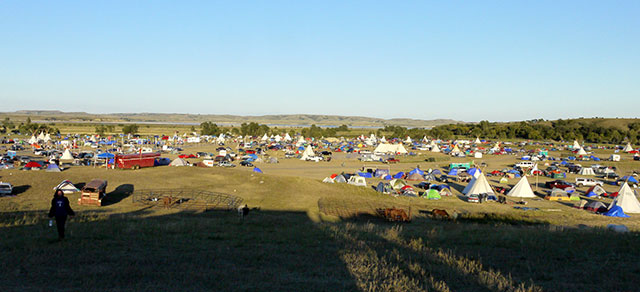 Oceti Sakowin camp seen from a hill on September 14, 2016. (Photo: Sarah Jaffe / BillMoyers.com)
Oceti Sakowin camp seen from a hill on September 14, 2016. (Photo: Sarah Jaffe / BillMoyers.com)
“We’re already winterizing in all aspects of the camp, young people working with the elders to find, whether it’s longhouses, whether it’s yurts, whether it’s any kind of structures that would keep us warm for the winter,” said Lay Ha, who traveled to North Dakota from the Wind River Reservation in Wyoming in late August and became part of the camp’s youth council.
As far as I can see, it’s just another way to lull us to sleep, make us go to sleep so we leave and then they’ll start again,” said Ista Hmi, an elder from Wanblee, South Dakota on the Pine Ridge Reservation and a member of the Seven Council Fires. “The Missouri [River] here, it was poisoned already from the pesticides and all that but we were still able to clean it,” he said. “But those are just topical compared to this oil. The oil, if it gets in here, it will start destroying the ecosystem underneath; it’ll be dead water.”
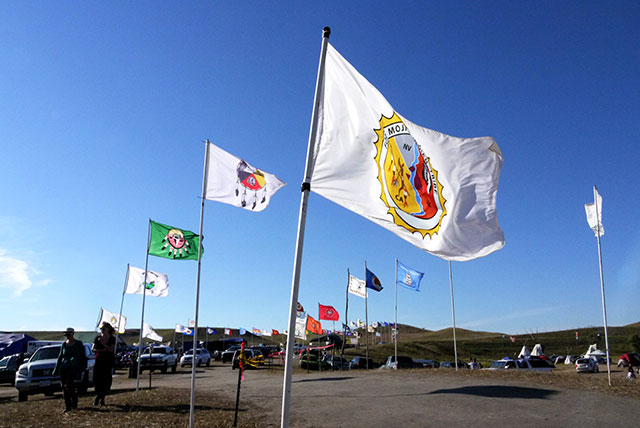 Flags at Oceti Sakowin camp, on September 14, 2016 (Photo: Sarah Jaffe / BillMoyers.com)
Flags at Oceti Sakowin camp, on September 14, 2016 (Photo: Sarah Jaffe / BillMoyers.com)
“We’re protecting the water, we’re not protesters,” explained Lay Ha. To him, as to many others in the camp, that the action is led by Native people, that it is built around their belief in nonviolence and in the spirit of prayer, is vital. It is, to them, much more than a protest.
Ha is Arapaho and Lakota on his father’s side and Eastern Shoshone on his mother’s; he is part of what has become the largest coming together of Native people in, many said, more than 100 years. The flags that flap overhead represent something more than a fight for clean water — they are a powerful statement of solidarity, a declaration of common interest.
***
The first camp you pass once through the checkpoint is a small one on the side of the road overlooking the construction site. Further along, signs, flags and banners hang from the barbed-wire fence along the road. A massive banner declares “No DAPL!” Spray-painted on a concrete barrier are the words “Children Don’t Drink Oil.” Then emerges the breathtaking sight of what is now called the Oceti Sakowin camp: Flags from well over 200 Native nations and international supporters line the driveway into the camp, flapping in the high plains wind. People ride through the camp on horseback. At the entrance, when you drive in, you are greeted by security and a man with burning sage to smudge your car. Just beyond, at the main fire, a microphone is set up for speakers and performers: When we arrived, Joan Baez sat by the fire, singing “Blowin’ in the Wind.”
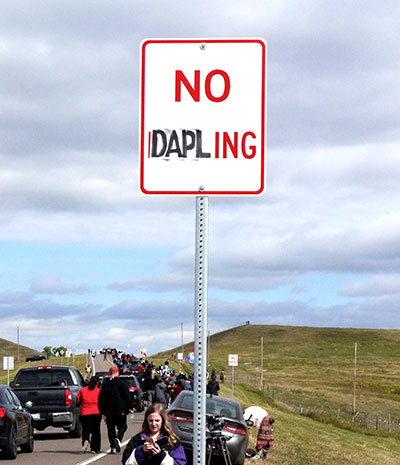 An “updated” road sign. Behind, people march from the Oceti Sakowin camp to the Dakota Access pipeline construction site, on September 13, 2016. (Photo: Sarah Jaffe / BillMoyers.com)Kandi Mossett of the Indigenous Environmental Network was wearing a “No Fracking” T-shirt when I met her at the media tent, doing an interview alongside a delegation from Ecuador of indigenous people who have also fought the oil companies there. She is from northwestern North Dakota, the Fort Berthold reservation, and the oil that would travel through the Dakota Access Pipeline is extracted from her community. She came to Standing Rock for the formation of the original camp, known as the Sacred Stone camp, on LaDonna Allard’s land. At first, she remembered, the camp had anywhere from five to 30 people. Then, when Energy Transfer Partners, the company behind the pipeline, put out notification that it was going to begin construction, the camp swelled to 200, then 700. It spilled over the river, into what was at first simply called the overflow camp. But as that camp grew, the campers began to feel it deserved its own name. Oceti Sakowin is the name for the Seven Council Fires, the political structure of what is known as the Great Sioux Nation. “We had for the first time in 200 years or more, the Seven Council Fires of the Great Sioux Nation coming together in one place to meet again,” Mossett said.
An “updated” road sign. Behind, people march from the Oceti Sakowin camp to the Dakota Access pipeline construction site, on September 13, 2016. (Photo: Sarah Jaffe / BillMoyers.com)Kandi Mossett of the Indigenous Environmental Network was wearing a “No Fracking” T-shirt when I met her at the media tent, doing an interview alongside a delegation from Ecuador of indigenous people who have also fought the oil companies there. She is from northwestern North Dakota, the Fort Berthold reservation, and the oil that would travel through the Dakota Access Pipeline is extracted from her community. She came to Standing Rock for the formation of the original camp, known as the Sacred Stone camp, on LaDonna Allard’s land. At first, she remembered, the camp had anywhere from five to 30 people. Then, when Energy Transfer Partners, the company behind the pipeline, put out notification that it was going to begin construction, the camp swelled to 200, then 700. It spilled over the river, into what was at first simply called the overflow camp. But as that camp grew, the campers began to feel it deserved its own name. Oceti Sakowin is the name for the Seven Council Fires, the political structure of what is known as the Great Sioux Nation. “We had for the first time in 200 years or more, the Seven Council Fires of the Great Sioux Nation coming together in one place to meet again,” Mossett said.
Faith Spotted Eagle is also part of the Seven Council Fires, from the Ihanktonwan or Yankton band. She too was there on what she remembered as a wintry, blowing day in April when the Sacred Stone camp first opened. An elder and grandmother, she had also been part of the successful fight against the Keystone XL Pipeline, and pointed out that the networks activated by that fight were coming together again in North Dakota. In 2013, she said, a dream of her grandmother sent her to look at the 1863 treaty between her people and the Pawnee. On the 150th anniversary of that treaty, Jan. 25, 2013, those nations, along with the Oglala and Ponca, signed the International Treaty to Protect the Sacred from Tar Sands Projects. “In that treaty, we declared that forevermore we would be allies to stop this extractive move to destroy Mother Earth from the Boreal forest down to the Gulf,” she said. Since that time, other nations have joined, and the treaty was renewed with prayers and a donation to the Sacred Stone camp.
“A lot of those networks, it took years for them to come together. Standing Rock will do the same thing for the next one. It is a progressive healing and learning,” Spotted Eagle continued. In the unlikely alliances that came together, from the Keystone XL fight to Standing Rock, with farmers and landowners joining their actions, she noted, “That was where the power was.”
To Dave Archambault II, the tribal chairman of the Standing Rock Sioux, the struggle — and the response from indigenous people — is global. He greeted reporters Sept. 14 alongside the delegation from Ecuador. “We all have similar struggles, where this dependency this world has on fossil fuels is affecting and damaging Mother Earth,” he said. “It is the indigenous peoples who are standing up with that spirit, that awakening of that spirit and saying, ‘It is time to protect what is precious to us.'” Nina Gualinga, one of the Ecuadorian visitors, noted, “The world needs indigenous people. The statistics say that we are 4 percent of the world’s population, but we are protecting more than 80 percent of the world’s biodiversity.”
In an age where courts have deemed corporate entities “persons” with legal rights, Spotted Eagle sees a certain symmetry in the encampment’s philosophy: “The corporations have become individuals, the privatization has given them rights of individuals to just go out and wreak havoc,” she said. “Well, the river has a right and that right is being infringed upon.”
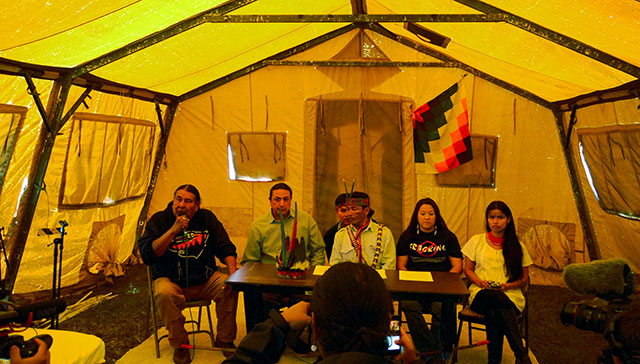 A press conference (from left to right) Tom Goldtooth of the Indigenous Environmental Network, Standing Rock Chairman Dave Archambault II, Ecuadorian environmental and Indigenous rights activist Franco Viteri, Kandi Mossett of the Indigenous Environmental Network and Ecuadorian environmental and Indigenous rights activist Nina Gualinga, September 14, 2016. (Photo: Sarah Jaffe / BillMoyers.com)
A press conference (from left to right) Tom Goldtooth of the Indigenous Environmental Network, Standing Rock Chairman Dave Archambault II, Ecuadorian environmental and Indigenous rights activist Franco Viteri, Kandi Mossett of the Indigenous Environmental Network and Ecuadorian environmental and Indigenous rights activist Nina Gualinga, September 14, 2016. (Photo: Sarah Jaffe / BillMoyers.com)
So do the people who live around it, she argues. “We are above all challenging the lack of consultation, of course, and the free prior and informed consent. Then, just our cultural freedom. We would never put a native pipeline underneath Arlington Cemetery,” Spotted Eagle added. But, she noted wryly, “It’s always a risk when you go into the courts. These courts are the courts of the conqueror.”
Winter will be hard, Spotted Eagle concedes. She said she hopes “the outside world will help” with donations. But, she added: “The ones that will stay are really going to have to bear down and address their cooperation even deeper, because if you go wandering off by yourself, you can perish, literally, up here.”
That outside support from individuals and environmental groups, she said, should respect the leadership of the Native people.” The message to the big greens is, stand by us, don’t co-opt us. And sometimes, they have to stand behind us, because 4,000, 7,000 Indians is a lot of Indians.”
Some of the campers were planning trips back and forth, while others were committed to staying. The nature of the camp has been to swell and shrink; on the weekends, Kandi Mossett said, it grows exponentially. The estimate of 7,000 at one time does not count all the people who have passed through briefly, bringing messages of solidarity from places like Charlotte, North Carolina and Flint, Michigan. “I have people calling me, emailing me every day: ‘I am going to be able to come out in two weeks, are you still going to be there?'” Mossett said. “I say, ‘Of course.'”
For those who can’t make it to the camp, Mossett noted, there are other ways that supporters have held actions in solidarity with the camps. “We are targeting the financers of this project: the banks,” she said.
There are petitions, Facebook pages for the Sacred Stone and Red Warrior camps, and a call for Barack Obama to visit the camp. “We will welcome you, we will greet you, we will feed you, we will put up a tepee for you,” Mossett said.
The long-term strategy, she said, is similar to that of the Keystone XL project. “They told us ‘You are crazy. It is a done deal.’ They told us that about the Keystone XL and they are telling us that now about Dakota Access, that it is a done deal. We respectfully disagree.” If the permit is granted, she said, they will continue to hold the space, to risk arrest, to halt construction. “Companies and shareholders, they only have so much patience and they are losing money,” she noted. “That is the bottom line: money. The more we can delay them, the more we can stall them, the more we know we are winning.”
The sentiments of Mossett and Spotted Eagle underscore what is perhaps most significant about the camps along the Cannonball River: What is happening here is something more than just a fight to stop a pipeline.
***
The word I heard over and over again from the people I interviewed was “decolonize.”
In the speak-outs and prayer circles, speaker after speaker, from the Pacific Northwest and from the Amazon, from New York to Arizona recalled the historic violence committed against Native American people not far from where the camp stood. Many recalled the Battle of the Greasy Grass, what is taught to schoolchildren as the Battle of Little Bighorn, which LaDonna Allard wrote was the last time the Oceti Sakowin came together. But for her and others, the massacres at Wounded Knee and Whitestone were closer to mind. It was the anniversary of the Whitestone massacre, where 250 women and children were killed by the US military, when private security guards turned dogs on the protesters at Standing Rock. It was Faith Spotted Eagle’s people, the Ihanktonwan, along with the Hunkpapa, that were killed there, and the use of police and security against peaceful protesters brought up those memories.
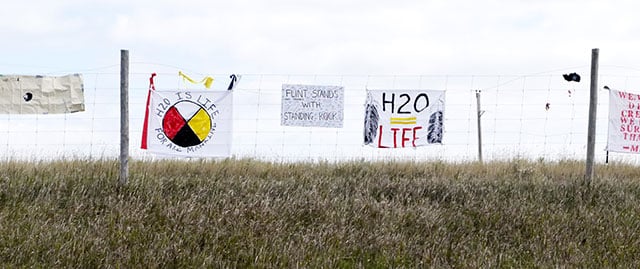 A sign along the highway near the Dakota Access pipeline construction site reads “Flint Stands with Standing Rock.” (Photo: Sarah Jaffe / BillMoyers.com)
A sign along the highway near the Dakota Access pipeline construction site reads “Flint Stands with Standing Rock.” (Photo: Sarah Jaffe / BillMoyers.com)
The echoes of historic struggles were everywhere, and to Spotted Eagle, they were reminders that the fight for the water is just a part of the fight for an entire way of life that was nearly crushed. She was raised speaking Dakota, and counted herself lucky to have her language and the worldview that came with it. The grass-roots organizing that brought together the camp, she said, was helping the Standing Rock people and other tribal governments to look past the structures imposed on them by the process of colonization. “If we don’t stop and every single day examine how I have become like the colonizer, I asked my daughter, ‘What is going to happen someday if we lose our songs, if we lose our language and we no longer think like Natives?’ She said, ‘Then the colonization process is complete.'”
In the camp, they experimented with bringing back the long-ago structure of the Oceti Sakowin. “The second part of that struggle is to wade through the colonialism that has happened between then and now and to figure out, ‘What can we bring back with some modifications that will work for the people?'” she said. “There have been a lot of attempts to revive the Oceti Sakowin, but it hasn’t happened because we didn’t have a common focus.”
The common struggle has in turn opened up a space for different people to come together and share their songs and dances, their prophecies and histories. The lack of good cell phone service, Lay Ha noted, forces people to be more present. “It just brings you back to the old days where you hear the language, you hear our culture, you get to see youth riding on horseback and it’s really a change, it’s really decolonizing ourselves.”
“We are at the right point in time,” Spotted Eagle agreed. “We are free at this space in time.”
Walking around the camp, you pass singing circles and the kitchen — Tuesday night the menu was moose, brought all the way from Maine by a visitor to the camp. A nurse from the medic tent made rounds, making sure that people knew that at night, the Standing Rock ambulance parked on the grounds would leave but the medics would be on duty. Young children played volleyball and posed for photographs, finished from their day at school — a fully recognized school that teaches both the core curriculum so children at the camp won’t fall behind their schools at home, and also teaches songs and dances, languages and history, about the treaties and the fight for the water.
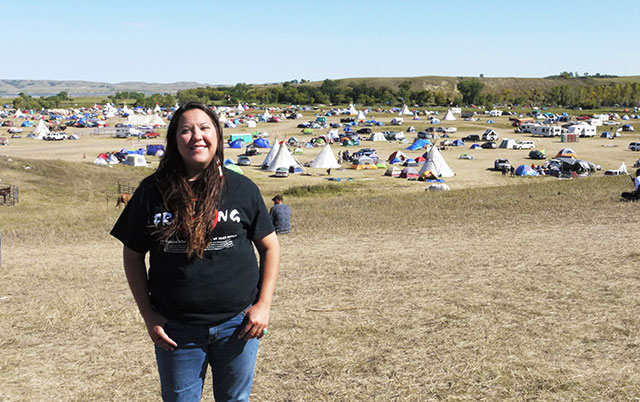 Kandi Mossett on a hill overlooking the Oceti Sakowin camp. (Photo: Sarah Jaffe / BillMoyers.com)
Kandi Mossett on a hill overlooking the Oceti Sakowin camp. (Photo: Sarah Jaffe / BillMoyers.com)
At night, campfires burned and tepees glowed, lit from within, as the open mic for speak-outs gave way to singing and dancing.
“We have had a few growing pains, but that is to be expected when you go from 30 people to 1,000 people in two or three days,” Mossett said. “There are a lot of logistics behind the scenes, things that people don’t see. Where are people going to go to the bathroom? Bringing in porta potties. Waste disposal. It was a really beautiful thing to see the community step up on our own and say, ‘Did you forget we are sovereign nations? We are going to do this and make it happen.'”
The coming together of the nations was something Mossett wanted for as long as she could remember, and that more than anything helped her envision a victory, not just against the Dakota Access Pipeline, not just against the whole extractive industry but for something much bigger.
“This pipeline would have already been built if we hadn’t come out here, taken back the power for ourselves and said, ‘Hey, nobody is going to help us or protect us except for us,'” Mossett said. “I think it was the nonviolent direct actions. In fact, I know that it was the nonviolent direct actions that got us to this point.”
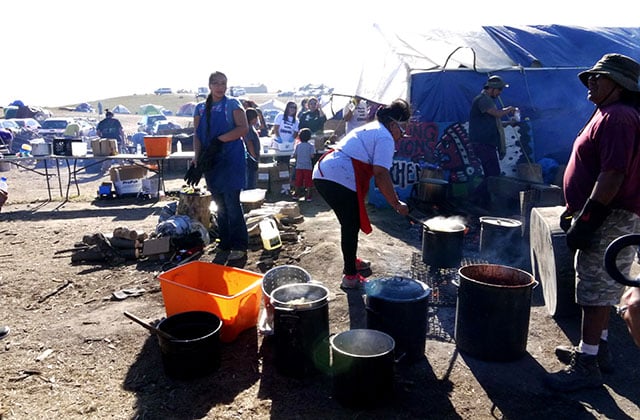 The kitchen at the Oceti Sakowin camp, September 14, 2016. (Photo: Sarah Jaffe / BillMoyers.com)
The kitchen at the Oceti Sakowin camp, September 14, 2016. (Photo: Sarah Jaffe / BillMoyers.com)
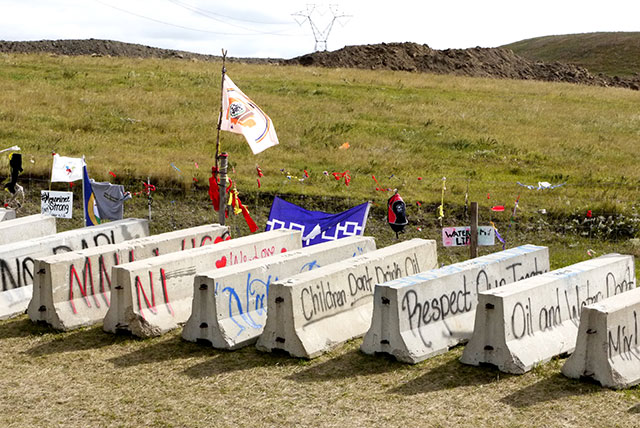 Cement barriers painted with messages, such as “Children Don’t Drink Oil,” near the pipeline construction site, September 13, 2016. (Photo: Sarah Jaffe / BillMoyers.com)
Cement barriers painted with messages, such as “Children Don’t Drink Oil,” near the pipeline construction site, September 13, 2016. (Photo: Sarah Jaffe / BillMoyers.com)
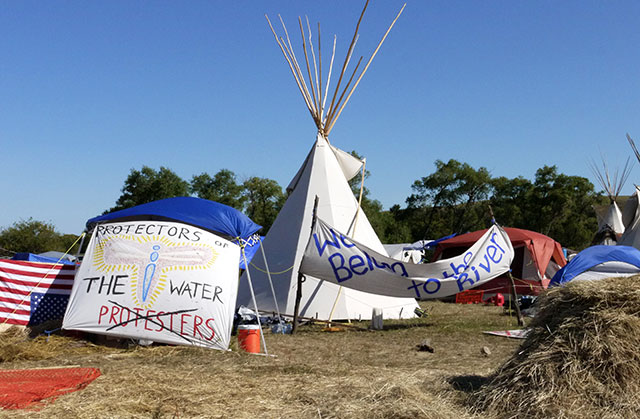 A sign reading “Protectors of the Water, not Protesters,” outside of the Red Warrior Camp, September 14, 2016. (Photo: Sarah Jaffe / BillMoyers.com)
A sign reading “Protectors of the Water, not Protesters,” outside of the Red Warrior Camp, September 14, 2016. (Photo: Sarah Jaffe / BillMoyers.com)
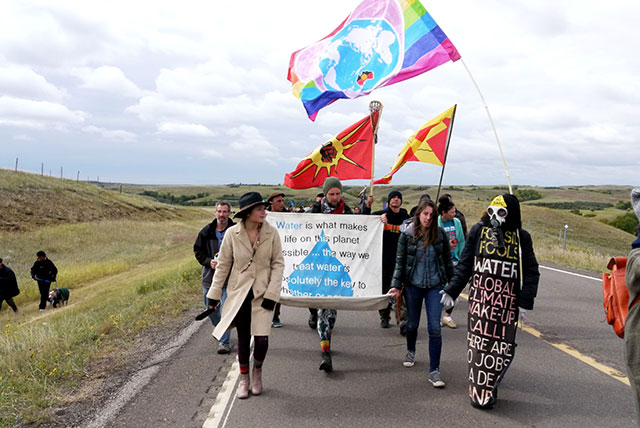 People from the Oceti Sakowin camp walking to the Dakota Access pipeline construction site near the Missouri River, whose waters they say they are trying to protect, September 13, 2016. (Photo: Sarah Jaffe / BillMoyers.com)
People from the Oceti Sakowin camp walking to the Dakota Access pipeline construction site near the Missouri River, whose waters they say they are trying to protect, September 13, 2016. (Photo: Sarah Jaffe / BillMoyers.com)
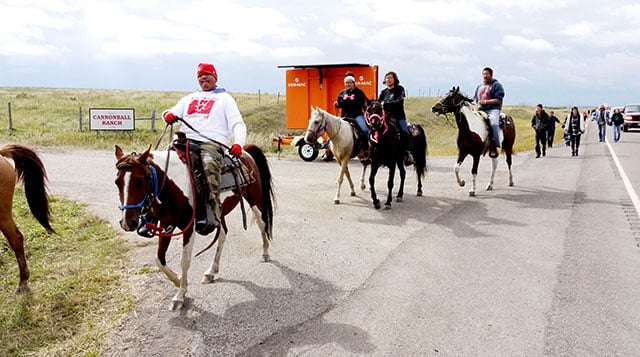 Horseback riders march from the Oceti Sakowin Camp to the Dakota Access pipeline construction site, September 13, 2016. (Photo: Sarah Jaffe / BillMoyers.com)
Horseback riders march from the Oceti Sakowin Camp to the Dakota Access pipeline construction site, September 13, 2016. (Photo: Sarah Jaffe / BillMoyers.com)
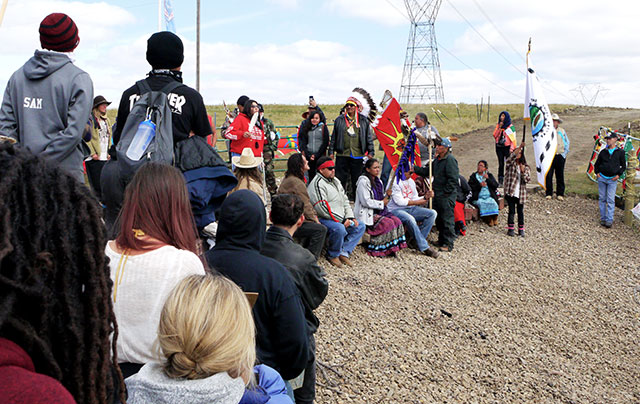 A “speak out” at the road to the Dakota Access pipeline construction site, September 13, 2016. (Photo: Sarah Jaffe / BillMoyers.com)
A “speak out” at the road to the Dakota Access pipeline construction site, September 13, 2016. (Photo: Sarah Jaffe / BillMoyers.com)
Our most important fundraising appeal of the year
December is the most critical time of year for Truthout, because our nonprofit news is funded almost entirely by individual donations from readers like you. So before you navigate away, we ask that you take just a second to support Truthout with a tax-deductible donation.
This year is a little different. We are up against a far-reaching, wide-scale attack on press freedom coming from the Trump administration. 2025 was a year of frightening censorship, news industry corporate consolidation, and worsening financial conditions for progressive nonprofits across the board.
We can only resist Trump’s agenda by cultivating a strong base of support. The right-wing mediasphere is funded comfortably by billionaire owners and venture capitalist philanthropists. At Truthout, we have you.
We’ve set an ambitious target for our year-end campaign — a goal of $230,000 to keep up our fight against authoritarianism in 2026. Please take a meaningful action in this fight: make a one-time or monthly donation to Truthout before December 31. If you have the means, please dig deep.